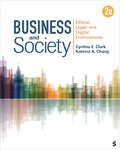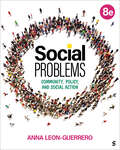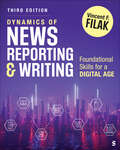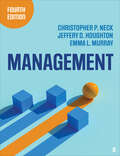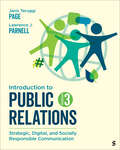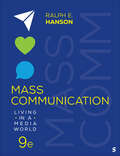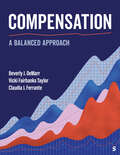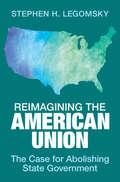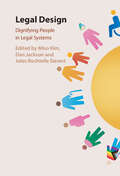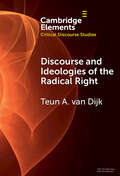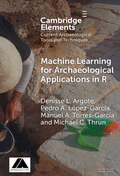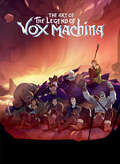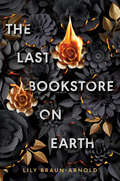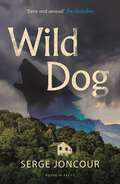- Table View
- List View
Business and Society: Ethical, Legal, and Digital Environments
by Cynthia E. Clark Kabrina K. ChangRecipient of a 2021 Most Promising New Textbook Award from the Textbook & Academic Authors Association (TAA) Business and Society: Ethical, Legal, and Digital Environments, Second Edition prepares students for the modern workplace by exploring the opportunities and challenges that individuals and businesses face in today′s increasingly global and digital world. Authors Cynthia E. Clark and Kabrina K. Chang present unique chapters on social media, big data and hacking, and privacy, diving deeper into the new legal and ethical challenges that are unleashed by our society′s use of and dependence on technology. Real-world case studies, ethical dilemmas, and point-counterpoint debates provide students with hands-on opportunities to apply chapter concepts and develop critical thinking skills as they explore the relationship among businesses, their stakeholders, and their shareholders. The Second Edition includes new cases and expanded coverage of global issues, the future of work, artificial intelligence and consumer rights.
Social Problems: Community, Policy, and Social Action
by Anna Leon-GuerreroIn Social Problems: Community, Policy, and Social Action, Anna Leon-Guerrero provides a thorough exploration of the social problems that permeate our world today. The book is designed around three key connections: the link between sociology and the study of social problems, the relationship between social problems and their solutions, and the personal connection readers can make in recognizing and addressing social problems in their own communities. Each chapter focuses on a specific social problem, examining its roots in social inequality and its manifestations in various social policies and programs. The Eighth Edition is enriched with personal stories of ordinary individuals who have accomplished extraordinary feats in their communities, providing readers with inspiration and guidance on how they too can make a difference.
Dynamics of News Reporting and Writing: Foundational Skills for a Digital Age
by Vincent F. FilakDynamics of News Reporting and Writing: Foundational Skills for a Digital Age shows students how to approach their stories and think on their feet in the evolving media landscape. Recognizing that well-crafted stories are founded on sharp prose, author Vincent F. Filak guides students through the essential elements of newswriting, such as lead writing, structure, and storytelling, in a chapter-by-chapter approach, while also teaching them how to think critically and focus on what matters most to their readers. The Third Edition features expanded writing and grammar exercises, discussions on social and digital media advancements, new coverage of artificial intelligence and generative AI, and additional career-related examples to help students succeed upon entering the field.
Management
by Christopher P. Neck Jeffery D. Houghton Emma L. MurrayManagement, Fourth Edition introduces students to the planning, organizing, leading, and controlling functions of management, with an emphasis on how managers can cultivate an entrepreneurial mindset. The text includes 34 case studies profiling a wide range of companies including The Progressive Corporation, Catch+Release, and Sephora. Authors Christopher P. Neck, Jeffery D. Houghton, and Emma L. Murray use a variety of examples, applications, and insights from real-world managers to help students develop the knowledge, mindset, and skills they need to succeed in today’s fast-paced, dynamic workplace.
Introduction to Public Relations: Strategic, Digital, and Socially Responsible Communication
by Janis Teruggi Page Lawrence J. ParnellIntroduction to Public Relations: Strategic, Digital, and Socially Responsible Communication presents a comprehensive introduction to the field of public relations, examining its current practices and future directions. In response to the dynamic shifts in technology, business, and culture, authors Janis T. Page and Lawrence J. Parnell illustrate how today’s PR professionals craft persuasive messages using modern technologies while working in line with the industry′s foundations. The text skillfully balances this approach by delving into communication theory, history, processes, and practices, demonstrating how these elements can be integrated into strategic public relations planning. Page and Parnell guide students toward becoming socially responsible communicators, where fostering trust and respect with diverse communities is valued over creating the next viral campaign. The Third Edition responds to the rising focus on social responsibility, sustainability, CEO and investor activism, and consumer demand for ethical brands, and addresses these changes with updated content, including new features, recent examples, case studies, and chapter-opening scenarios.
Mass Communication: Living in a Media World
by Ralph E. HansonThe best-selling Mass Communication: Living in a Media World offers an accessible introduction to mass communication, equipping students with the critical thinking skills to become savvy media consumers. Using a storytelling approach, the text weaves in examples drawn from everyday life, making it easier for students to retain the material and connect it to their own media experiences. Readers are encouraged to consider the media industry from the inside out and, in doing so, discover the many dimensions of mass communication that operate in our society. This newly revised Ninth Edition highlights the aftermath of how the media industry and media consumers have evolved since the global pandemic, closely examining the changing the face of media today.
Social Problems: Community, Policy, and Social Action
by Anna Leon-GuerreroIn Social Problems: Community, Policy, and Social Action, Anna Leon-Guerrero provides a thorough exploration of the social problems that permeate our world today. The book is designed around three key connections: the link between sociology and the study of social problems, the relationship between social problems and their solutions, and the personal connection readers can make in recognizing and addressing social problems in their own communities. Each chapter focuses on a specific social problem, examining its roots in social inequality and its manifestations in various social policies and programs. The Eighth Edition is enriched with personal stories of ordinary individuals who have accomplished extraordinary feats in their communities, providing readers with inspiration and guidance on how they too can make a difference.
Management
by Christopher P. Neck Jeffery D. Houghton Emma L. MurrayManagement, Fourth Edition introduces students to the planning, organizing, leading, and controlling functions of management, with an emphasis on how managers can cultivate an entrepreneurial mindset. The text includes 34 case studies profiling a wide range of companies including The Progressive Corporation, Catch+Release, and Sephora. Authors Christopher P. Neck, Jeffery D. Houghton, and Emma L. Murray use a variety of examples, applications, and insights from real-world managers to help students develop the knowledge, mindset, and skills they need to succeed in today’s fast-paced, dynamic workplace.
Family Life Now
by Kelly J. WelchWritten with a down-to-earth and student-focused approach, Family Life Now, 4th edition, delivers a comprehensive examination of interaction among family members and intimate partners. With an emphasis on today’s diverse and complex individual, family, and the evolving impact of societal issues, this text engages students through a balanced, integrated approach of the human development and family science disciplines. Author Kelly Welch uses a first-person narrative style of writing to engage readers, encourage them draw upon their own background and experiences to understand theories and concepts, and to paint a realistic view of families and intimate relationships. This text lays the foundation to understanding relationships better, applying research and theory, and promotes the ways in which those considering a helping profession career (such as social worker, therapist, psychologist, teacher, early childhood, childcare provider, or healthcare provider) can employ strengths-oriented, best practices to create and deliver effective, quality couple and family life education.
Dynamics of News Reporting and Writing: Foundational Skills for a Digital Age
by Vincent F. FilakDynamics of News Reporting and Writing: Foundational Skills for a Digital Age shows students how to approach their stories and think on their feet in the evolving media landscape. Recognizing that well-crafted stories are founded on sharp prose, author Vincent F. Filak guides students through the essential elements of newswriting, such as lead writing, structure, and storytelling, in a chapter-by-chapter approach, while also teaching them how to think critically and focus on what matters most to their readers. The Third Edition features expanded writing and grammar exercises, discussions on social and digital media advancements, new coverage of artificial intelligence and generative AI, and additional career-related examples to help students succeed upon entering the field.
Mass Communication: Living in a Media World
by Ralph E. HansonThe best-selling Mass Communication: Living in a Media World offers an accessible introduction to mass communication, equipping students with the critical thinking skills to become savvy media consumers. Using a storytelling approach, the text weaves in examples drawn from everyday life, making it easier for students to retain the material and connect it to their own media experiences. Readers are encouraged to consider the media industry from the inside out and, in doing so, discover the many dimensions of mass communication that operate in our society. This newly revised Ninth Edition highlights the aftermath of how the media industry and media consumers have evolved since the global pandemic, closely examining the changing the face of media today.
Business and Society: Ethical, Legal, and Digital Environments
by Cynthia E. Clark Kabrina K. ChangRecipient of a 2021 Most Promising New Textbook Award from the Textbook & Academic Authors Association (TAA) Business and Society: Ethical, Legal, and Digital Environments, Second Edition prepares students for the modern workplace by exploring the opportunities and challenges that individuals and businesses face in today′s increasingly global and digital world. Authors Cynthia E. Clark and Kabrina K. Chang present unique chapters on social media, big data and hacking, and privacy, diving deeper into the new legal and ethical challenges that are unleashed by our society′s use of and dependence on technology. Real-world case studies, ethical dilemmas, and point-counterpoint debates provide students with hands-on opportunities to apply chapter concepts and develop critical thinking skills as they explore the relationship among businesses, their stakeholders, and their shareholders. The Second Edition includes new cases and expanded coverage of global issues, the future of work, artificial intelligence and consumer rights.
Compensation: A Balanced Approach
by Beverly J. DeMarr Vicki Taylor Claudia J. FerranteCompensation: A Balanced Approach 1e takes an applied approach to covering compensation systems and practices by balancing theory and research with exercises and applications. Each chapter looks at compensation from both the employer and employee perspective, giving students a more holistic understanding of the role total rewards play in an organization. Authors Beverly J. DeMarr, Vicki Fairbanks Taylor, and Claudia J. Ferrante help students develop the ability to think critically and ethically about compensation decisions and their effects on both employers and employees.
Compensation: A Balanced Approach
by Beverly J. DeMarr Vicki Taylor Claudia J. FerranteCompensation: A Balanced Approach 1e takes an applied approach to covering compensation systems and practices by balancing theory and research with exercises and applications. Each chapter looks at compensation from both the employer and employee perspective, giving students a more holistic understanding of the role total rewards play in an organization. Authors Beverly J. DeMarr, Vicki Fairbanks Taylor, and Claudia J. Ferrante help students develop the ability to think critically and ethically about compensation decisions and their effects on both employers and employees.
Reimagining the American Union: The Case for Abolishing State Government
by Stephen H. LegomskyReimagining the American Union challenges readers to imagine an America without state government. No longer a union of arbitrarily constructed states, the country would become a union of its people. The first book ever to argue for abolishing state government in the US, it exposes state government as the root cause of the gravest threats to American democracy. Some of those threats are baked into the Constitution; others are the product of state legislatures abusing their already-constitutionally-outsized powers through gerrymanders, voter suppression schemes, and other less-publicized manipulations that all too often purposefully target African-American and other minority voters. Reimagining the American Union goes on to demonstrate how having three levels of legislative bodies (national, state, and local) – and three levels of taxation, bureaucracy, and regulation – wastes taxpayer money and pointlessly burdens the citizenry. Two levels of government – national and local – would do just fine. After debunking the offsetting benefits typically claimed for state government, the book concludes with a portrait of what a new, unitary American republic might look like.
Legal Design: Dignifying People in Legal Systems
by Dan Jackson Miso Kim Jules Rochielle SievertLegal design is a rapidly growing field that seeks to improve the legal system's accessibility, usability, and effectiveness through human-centered design methods and principles. This book provides a comprehensive introduction to legal design, covering fundamental concepts, definitions, and theories. Chapters explore the role of legal design in promoting dignity, equity, and justice in the legal system. Contributors present a range of community-driven projects and method-focused case studies that demonstrate the potential of legal design to transform how people experience the law. This book is an essential resource for anyone interested in the future of law and the intersection of design and justice.
Control (Elements in Generative Syntax)
by Idan LandauThis Elements presents the major findings and theoretical advances in the area of Control. We describe the different types of control (complement, adjunct, obligatory, nonobligatory) and illustrate their profiles in several languages. It is shown that while certain features of Obligatory Control (OC) are common – nullness of PRO, nonfinite complements – they are not universal, hence should not enter its core definition. Comparing approaches to the choice of controller based on lexical meaning postulates with those based on embedding of speech acts, we conclude that the latter provide deeper insights into the core properties of OC. The fundamental semantic distinction between clauses denoting a property and those denoting a proposition proves to be important: It affects both the possibility of Partial Control in complements and the possibility of Non Obligatory Control in adjuncts. These insights are integrated in the Two-Tiered Theory of Control, laid out in the final sections.
Environmental Foundations to the Rise of Early Civilisations in China (Elements in Ancient East Asia)
by Yijie ZhuangThe transition from the middle to late Holocene (5000–4000 BP) coincided with profound socioeconomic transformations and intensified regional and trans-regional interactions in late prehistoric China. These environmental and socioeconomic changes gave rise to diverse lifeways and settlement modes that constituted the foundation for the emergence of regional civilisations. In this Element, prehistoric China is divided roughly into the Highlands, Lowlands, and Coastal areas, each with unique environmental and ecological conditions and distinctive technological and economic traditions between 5000–4000 BP. The author gathers and reviews large amounts of environmental and archaeological data, and reconstructs brief environmental and settlement changes and lifeways. The author argues that environmental conditions and subsistence adaptations are two of the engines driving the increased socioeconomic complexity and rise of civilisations in the late prehistoric China. This title is also available as Open Access on Cambridge Core.
Discourse and Ideologies of the Radical Right (Elements in Critical Discourse Studies)
by Teun A. van DijkThere has been much scholarly attention for the radical right, especially in political science. Unfortunately, this research pays less attention to the discourse of the radical right, a topic especially studied by scholars in discourse studies. Especially lacking in this research in various disciplines is a theoretically based analysis of ideology. This Element first summarizes the authors theory of ideology and extends it with a new element needed to account for the ideological clusters of political parties. Then a systematic analysis is presented of the discourses and ideologies of radical right parties in Chile, Spain, the Netherlands and Sweden. From a comparative perspective it is concluded that radical right discourse and ideologies adapt to the economic, cultural, sociopolitical and historical contexts of each country.
Machine Learning for Archaeological Applications in R (Elements in Current Archaeological Tools and Techniques)
by Denisse L. Argote Michael C. Thrun Pedro A. López-García Manuel A. Torres-GarcíaThis Element highlights the employment within archaeology of classification methods developed in the field of chemometrics, artificial intelligence, and Bayesian statistics. These run in both high- and low-dimensional environments and often have better results than traditional methods. Instead of a theoretical approach, it provides examples of how to apply these methods to real data using lithic and ceramic archaeological materials as case studies. A detailed explanation of how to process data in R (The R Project for Statistical Computing), as well as the respective code, are also provided.
The Heart Healthy Plant-Based Cookbook: Over 100 Recipes for Lowering Blood Pressure, Reversing Heart Disease & Cardiac Recovery
by Hari Pulapaka Jenneffer PulapakaDiscover the ultimate guide to heart health with The Heart Healthy Plant-Based Cookbook.Unlock the secrets to a healthier heart with over 100 easy, oil-free, and salt-free recipes designed not only to prevent and reverse heart disease but also to tantalize your taste buds with delicious flavors.Written by lifestyle medicine expert Dr. Jenneffer Pulapaka and professional chef Hari Pulapaka, The Heart Healthy Plant-Based Cookbook combines culinary expertise with medical knowledge to create an essential collection of recipes so flavorful, it's almost impossible to tell they're good for you.Why Choose a Plant-Based Diet?Heart disease remains the leading cause of death in the US. Research shows that a plant-based, low-sodium, low-fat, oil-free diet, combined with regular exercise, not only reduces the risk of heart disease but is also crucial for recovery. Embrace a healthier lifestyle with recipes that support heart health and overall well-being.What's Inside The Heart Healthy Plant-Based Cookbook:• Breakfast, Lunch, Dinner, and Dessert Recipes: Start your day with Blueberry and Oats Pancakes or enjoy a hearty Sweet Potato, Kale, and Mushroom Scramble. Savor a Roasted Vegetable Tikka Masala Curry for dinner or indulge in a Green Chile and Corn Chowder.• Pantry Staples and Special Seasoning Blends: Stock your kitchen with essential ingredients and unique seasoning blends to enhance your meals.• Soups and Sauces: Warm up with Rapini, Garlic, and White Bean Soup or try the Plantain and Lima Bean Mofongo.• Healthy Eating Habits: Learn key habits for a healthier heart with our comprehensive primer.Transform your diet and improve your heart health with The Heart Healthy Plant-Based Cookbook. Order your copy today and start your journey to a healthier, happier you!
The Art of The Legend of Vox Machina
by Meredith KecskemetyThe adventure begins in the hit TV series The Legend of Vox Machina! Follow Vex&’halia, Vax&’lidan, Keyleth, Grog Strongjaw, Scanlan Shorthalt, Pike Trickfoot, and Percy de Rolo as they set off to save Exandria from dark forces.Experience Exandria again with character breakdowns, concept art, and a behind-the-scenes look into the creation of the show with Legend of Vox Machina writer Meredith Kecskemety, along with special commentary from the cast.
The Last Bookstore on Earth
by Lily Braun-ArnoldTwo teen girls fall in love and fight for survival in an abandoned bookstore weeks before another cataclysmic storm threatens to bring about the end of the world in this unforgettable YA debut. Perfect for fans of Station Eleven and The Last of Us.&“A thoroughly original, intimate, and sometimes harrowing meditation on survival, forgiveness, and learning how to love again at the almost end of the world.&”—Nicola Yoon #1 New York Times bestselling author The world is about to end. Again.Ever since the first Storm wreaked havoc on civilization as we know it, seventeen-year-old Liz Flannery has been holed up in an abandoned bookstore in suburban New Jersey where she used to work, trading books for supplies with the few remaining survivors. It&’s the one place left that feels safe to her.Until she learns that another earth-shattering Storm is coming . . . and everything changes.Enter Maeve, a prickly and potentially dangerous out-of-towner who breaks into the bookstore looking for shelter one night. Though the two girls are immediately at odds, Maeve has what Liz needs—the skills to repair the dilapidated store before the next climate disaster strikes—and Liz reluctantly agrees to let her stay.As the girls grow closer and undeniable feelings spring up between them, they realize that they face greater threats than the impending Storm. And when Maeve&’s secrets and Liz&’s inner demons come back to haunt them both, they find themselves fighting for their lives as their world crumbles around them.&“A hauntingly beautiful story of love, loss, and the raw fight for survival.&” —Jarrod Shusterman, New York Times bestselling author of Dry&“Hopeful, thrilling, and twisty…the snarky sapphic dystopian of our dreams.&” —Jennifer Dugan, author of Some Girls Do
Tidy Up Your Life: Rethinking How to Organize, Declutter, and Make Space for What Matters Most
by Tyler MooreBring order to your home and focus to your busy life with Tidy Dad&’s guiding principles and practical routines for organizing, cleaning, and prioritizing—both emotionally and physically.A father of three with a stressful job, Tyler Moore felt his life resembled an overstuffed closet: disorganized and overly busy behind tidy, closed doors. When it all became too much—for his family's 750-square-foot apartment and his mental health—he set out to unpack the physical and emotional mess around him.Chronicling his progress as &“Tidy Dad&” on Instagram, Moore learned that tidying is about so much more than the aesthetics and decluttering of a physical space. When he stepped back, reflected, and named what was "just enough," he was able to devise systems and hacks that brought order to his whole life. Drawing on Moore's experience with the everyday highs and lows of parenting, home management, and work-life balance, and filled with his signature warmth and wit, Tidy Up Your Life includes: Tidy Dad&’s process for tackling overwhelming tasks—how to identify what really matters both emotionally and physically to you and the people who share your space. How to arrive at your own definition of "just enough" as well as thought experiments for appreciating what you already have.The goal is not "always tidy" but "easily tidied" and other principles for lifting some of the mental and physical burdens we feel when managing our homes. Tips for making a &“one-area-a-weekday&” cleaning schedule and other simple routines that compliment household rhythms and reduce the mental load you may be carrying.A vital book for overwhelmed parents as well as overworked, stressed-out professionals, Tidy Up Your Life will help you live a more joyful, tidied-up life.
Wild Dog: Sinister and savage psychological thriller
by Serge JoncourFranck and Lise, a Parisian couple in the film industry, rent a cottage in the quiet hills of the French Lot, with no phone signal, to get away from the stresses of modern life. A mysterious dog emerges, looking for a new master. Ghosts of a dark past run wild. They meet a German lion tamer, who took refuge during the First World War . . .Faced with nature at its most brutal, the holiday-makers are about to discover that man and beast have more in common than they think.
